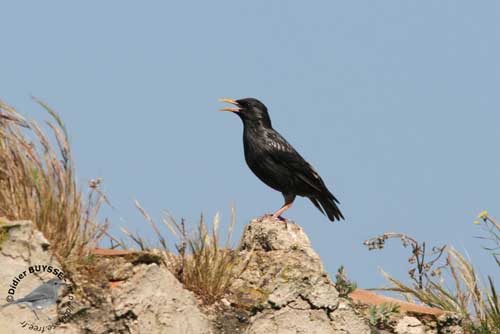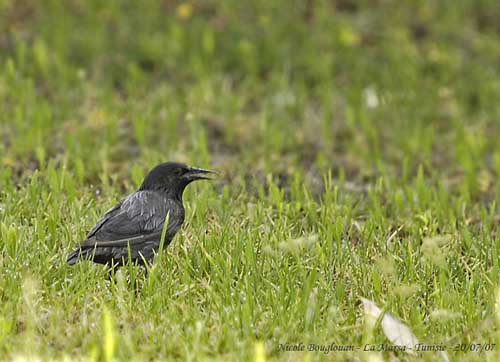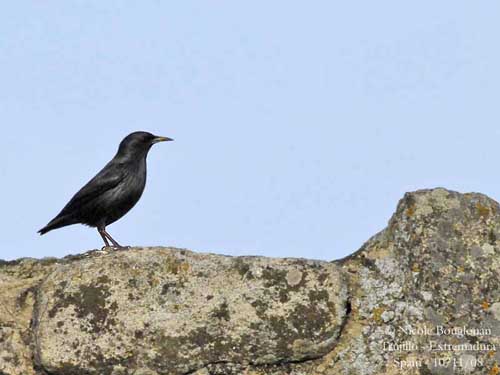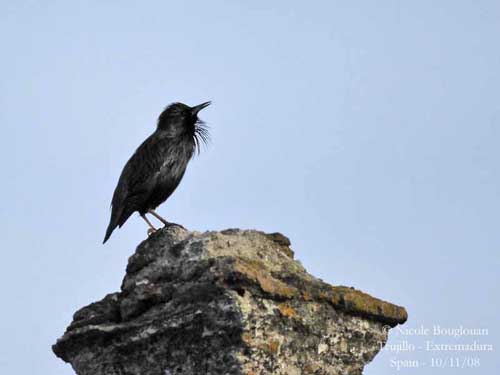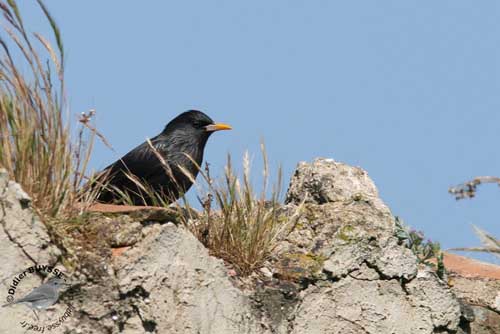
Fr: Etournau unicolore
All : Einfarbstar
Esp : Estornino Negro
Ital: Storno nero
Nd: Zwarte Spreeuw
Sd: Svartstare
Port: Estorninho-preto
Photographers:
José Luis Beamonte
Pájaros de España
Didier Buysse
Vision d’Oiseaux
Jean Michel Fenerole
Photos d’Oiseaux du monde
Nicole Bouglouan
PHOTOGRAPHIC RAMBLE
Text by Nicole Bouglouan
Sources:
HANDBOOK OF THE BIRDS OF THE WORLD Vol 14 by Josep del Hoyo-Andrew Elliot-David Christie - Lynx Edicions – ISBN: 9788496553507
ENCYCLOPEDIE DES OISEAUX DE FRANCE ET D’EUROPE – de Peter Hayman et Rob Hume - Flammarion – ISBN : 2082009920
LE GUIDE ORNITHO par Grant, Mullarney, Svensson, Zetterström - Delachaux Niestle - ISBN: 2603011421
THE HANDBOOK OF BIRD IDENTIFICATION FOR EUROPE AND THE WESTERN PALEARCTIC by Mark Beaman, Steve Madge - C.Helm - ISBN: 0713639601
BirdLife International (BirdLife International)
Pájaros de España (JL Beamonte)
Wikipedia, the free encyclopaedia
Spotless Starling
Sturnus unicolor
Passeriforme Order – Sturnidae Family
BIOMETRICS:
Length: 22 cm
Weight: 70-100 g
DESCRIPTION:
Closely related to the Common Starling (S. vulgaris), the Spotted Starling is largely sedentary within its restricted range.
The adult male has glossy black plumage overall, with purplish iridescence on head and upperbreast, and green on back and belly. The wings are glossy black with some mauve wash on flight feathers. The tail is blackish-brown.
The head is glossy black, and we can see greatly elongated feathers on crown, nape, throat and upperbreast.
The bill is yellow with pale bluish-grey base. The eyes are dark brown. Legs and feet are reddish-pink.

In fresh plumage after the post-breeding moult, feathers are edged pale greyish. The bill is black. Legs and feet are usually duller and darker.
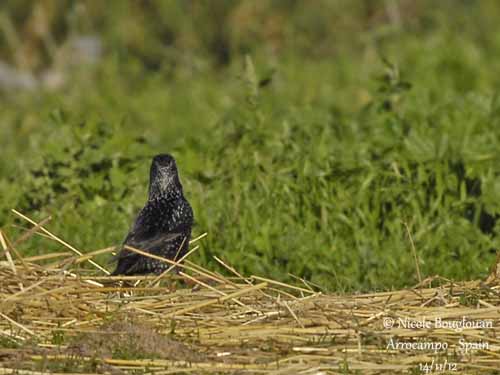
The female is similar to the male but she has less glossy plumage. Head and upperbreast show shorter feathers. The wings feathers have paler edges.
Outside the breeding season, she appears more greyish than the male. The eyes are brown with paler inner or outer ring.
In breeding plumage, she has yellow bill with pinkish-brown base, and brownish-pink legs and feet.
The juvenile has brown plumage overall, usually darker then juvenile S. vulgaris, with no streaking. The bill is blackish. Eyes, legs and feet are brown.
After the moult, it resembles non-breeding adult with small pale feather tips overall.
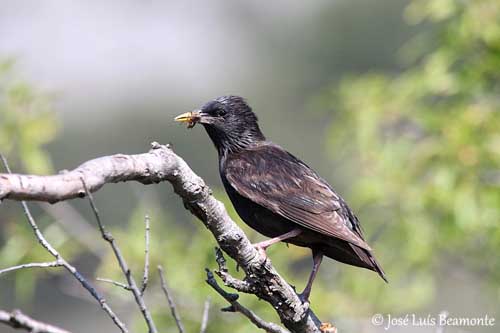
VOICE: SOUNDS BY XENO-CANTO
The Spotted Starling male sings all year round, but both sexes sing at roost and during winter. The song includes melodious, loud whistles and warbling phrases with mimicry of at least 15 other bird species.
During courtship, the male sings while fluffing out the long throat and upperbreast feathers and moving its half-open wings.
During the non-breeding season, the most frequent sounds are whistles. Alarm calls are harsh, and we can also hear high-pitched distress calls.
When both S. vulgaris and S. unicolor gather at the same areas in NE Spain, they share the same dialect and use similar repertoire of sounds.
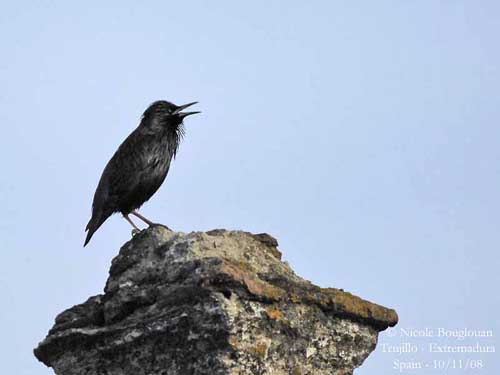
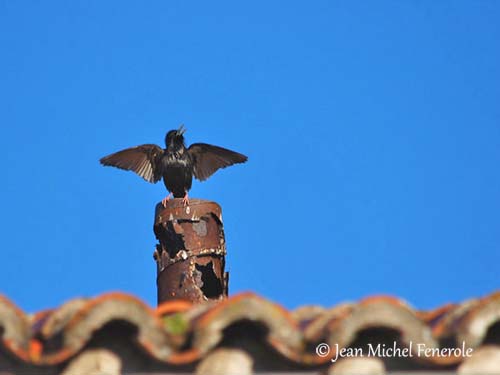
HABITAT:
The Spotted Starling frequents open woodlands, short grass areas and pastures. It is often seen in cultivated fields, but also in urban parks and gardens in cities. This species is visible up to 2500 metres of elevation during summer.
They gather at communal roosts all year round, with mainly young birds in summer. They can form mixed winter roosts with the Common Starling.
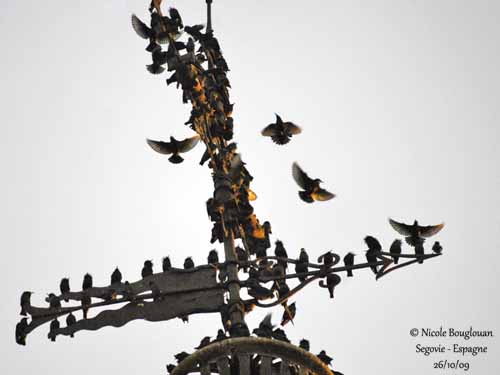
RANGE:
The Spotted Starling is found in Iberian Peninsula, S France, N Africa and Mediterranean islands such as Corsica, Sardinia and Sicily.
BEHAVIOUR:
The Spotted Starling is omnivorous. During spring and summer, it feeds primarily on animal food such as various insects, but also small frogs and toads, lizards and small rodents. In autumn and winter, it feeds on fruit and seeds, buds and flowers from elm and poplar, and cultivated fruits.
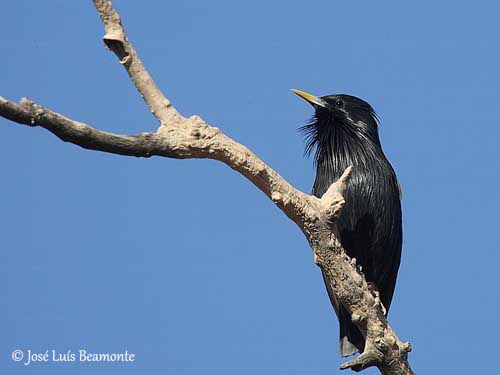
It feeds mainly on the ground by probing for invertebrates with open bill. In pastures, it hawks insects flushed by cattle, and removes tics and flies from their bodies. It also forages in foliage where it catches invertebrates.
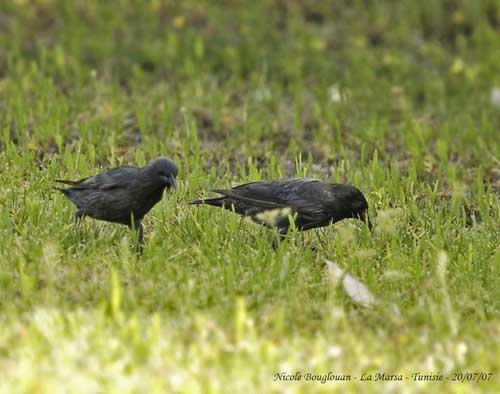
During the breeding season, males can be polygynous, usually one male with two females. But less than 5% of males show this behaviour. They are colonial nesters and may breed in mixed colonies with S. vulgaris in NE Spain. The breeding behaviour of both species is synchronized.
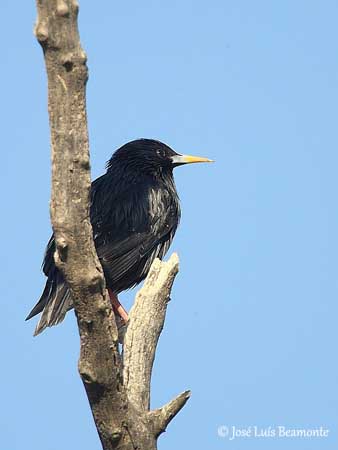
The Spotted Starling is sedentary in its range, only performing seasonal dispersal in S Spain.
FLIGHT:
The winter flocks of Spotted Starlings move in typical style, with birds from the rear flying forwards to land in front. The flight is fast. Flocks perform aerial gyrations before to reach the nightime roosts.
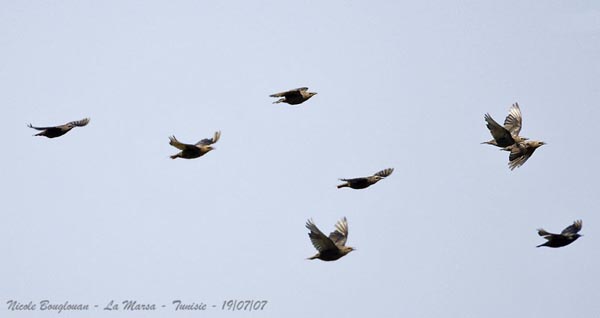
REPRODUCTION:
The breeding season occurs between April and mid-July in Spain and from March to July in Morocco.
The Spotted Starling breeds in colonies. It is cavity-nester and builds the nest in natural cavities such as abandoned woodpecker hole in tree, sometimes old burrow of European Bee-eater or Collared Sand Martin, also in old nest of White Stork, Eurasian Jackdaw or House Sparrow. But it also uses artificial structures such as tile-roofs, cavity in walls or buildings, and even nest-boxes.
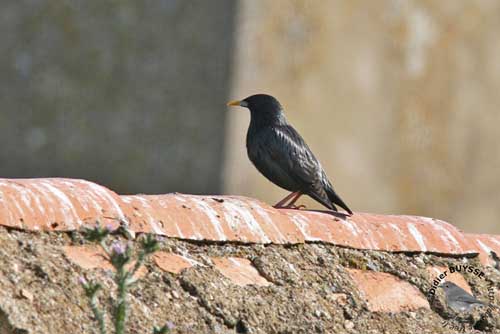
The nest is built by both adults with dry grass. The lining includes grass, roots, leaves and feathers.
Some yellow flowers can be included in the structure, and also fresh green leaves. Prior to incubation and in order to stimulate the female, the male adds aromatic fresh leaves to the nest as part of courtship displays, while the female adds feathers in response to the male’s display.
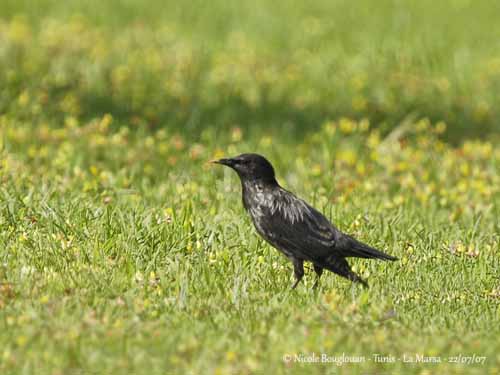
She lays 4-5 pale blue-green eggs and incubates during 11-14 days. The male may incubates sometimes too. Both parents feed the chicks and clean the nest, but the female performs most of nesting duties.
The young fledge about three weeks after hatching, and are still fed by parents during some days. They form flocks of juveniles a few days after fledging, and leave the nesting area.
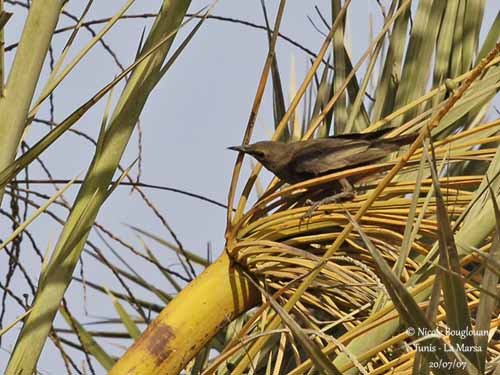
This species produces one or two broods per season.
Some brood parasitism occurs, but parents eject these eggs from the nest. Success of parasitic eggs is less than 10 % of the reproduction.
DIET:
The Spotted Starling feeds on animal food during spring and summer, including insects, small amphibians, lizards and small rodents. In autumn and winter, it feeds on seeds and fruits, and other plant matter.
It feeds mainly on the ground and forages in foliage.
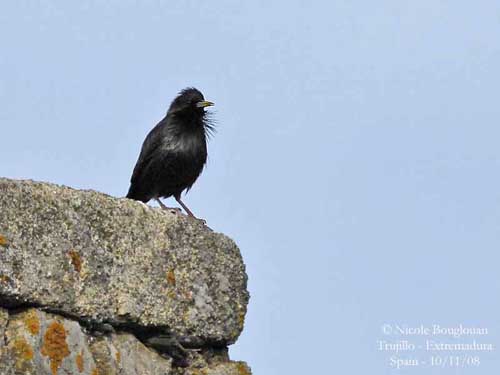
PROTECTION / THREATS / STATUS:
The Spotted Starling is common to locally abundant. They may damage fruit crops such as olive and cherry crops in some parts of the range.
The species is not currently threatened.
